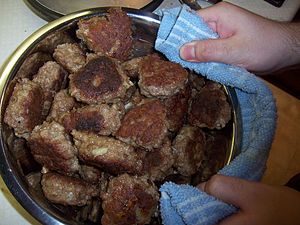food.wikisort.org - Dish
A frikadelle (plural frikadellen) is a rounded, flat-bottomed, pan-fried meatball of minced meat, often likened to the German version of meatballs. The origin of the dish is unknown. The term frikadelle is German but the dish is associated with German, Scandinavian and Polish cuisines.[citation needed] It is considered a national dish in Denmark.[1] They are one of the most popular meals in Poland, where they are known as kotlety mielone.[citation needed] In Norway, the dish is known as kjøttkaker, and in Sweden as pannbiff.
This article includes a list of general references, but it lacks sufficient corresponding inline citations. (September 2015) |
There are various local variants of frikadelle throughout Scandinavia, as both a main course and a side dish. In Sweden, the word frikadeller refers to meatballs that are boiled, not pan-fried.[2]
Etymology
The origin of the word is uncertain. According to the Etymologisches Wörterbuch des Deutschen, Frikadelle (pl. Frikadellen) can be found end of the 17th century in German, and is related to the Italian frittatella, French fricandeau, and Latin frīgere ('to roast').[3] Other variants used in Germany are Boulette/Bulette, Bratklops, Fleischpflanzerl, Fleischlaberl, Fleischküchle and Grillette/Grilletta as well as the Austrian Faschiertes Laibchen. It may be derived from fricandeau de veau, a dish of sliced veal, larded with pork fat.[4] In the Dictionnaire des dictionnaires (1837) fricadelle is defined as, "In Belgium, a ball of minced, cooked meat" and a separate word, fricadèle, is defined as fricandeau.[5] And in Phillips's New World of Words (1706) it is defined as "Fricandoe, a sort of Scotch Collops made of thin slices of Veal, well larded and stuff'd." The Oxford English Dictionary defines fricandele (variation fricadelle) as a "quasi-French form of fricandeau".[6]
Other variations

Denmark
In Denmark, traditionally, they are made from minced veal, pork or beef (or a blend of two of these meats); chopped onions; eggs; milk (or water); bread crumbs (or oatmeal or flour); salt; and pepper; then formed into balls by using a tablespoon to get the right size frikadelle and flattened somewhat. They are then pan-fried in pork fat or beef fat, or more commonly in modern times in butter, margarine or even vegetable oil. Another popular variation is fiskefrikadeller replacing the meat with fish (mostly cod, but sometimes cod and salmon) as the main ingredient and often served with remoulade.
As a main dish, they are most often served with boiled white potatoes and gravy (brun sovs) accompanied by pickled beetroot or cooked red cabbage. Alternatively, they can be served with creamed, white cabbage.
Frikadeller are also eaten on ryebread (rugbrød) with red cabbage or pickle slices as a traditional Danish smørrebrød.
The combination of frikadeller and a cold potato salad is very popular at picnics or potlucks, due to the ease of transporting either component after cooking.
Indonesia
Frikadel are also known in Indonesian cuisine through Dutch cuisine (of the frikadel, which is historically similar to the frikadaller) influence and called perkedel, however the main ingredient is not meat, but mashed potato, sometimes slightly mixed with ground meat or corned beef. The mixture is then shaped into flat round patties and dipped in egg yolk before being deep fried. Other than mashed potato, cabe rawit, spring onion, shrimp, peeled corn, or mashed tofu fritters are also common as perkedel ingredients.
See also
- Frikkadel
- Frikandel
- Faggot (food)
- Hamburg steak
- Hamburger
- Shami kebab
- List of meatball dishes
- Perkedel
- Cuisine of Denmark
- Cuisine of Germany
- Cuisine of Norway
- Salisbury steak
- South African cuisine
- Skilpadjies
- Swedish meatball
- Dry meatballs
- Tteok-galbi
References
- Notaker, Henry (December 30, 2008). Food Culture in Scandinavia. ABC-CLIO. p. 94. Retrieved 25 August 2021.
- "frikadell | SAOB" (in Swedish). Retrieved 2021-12-22.
- "Frikadelle". www.dwds.de. Berlin-Brandenburg Academy of Sciences and Humanities. Retrieved 2017-01-11.
- Éric Boschman; Nathalie Derny (2008) "La Fricadelle", Le Goût des Belges, vol. 2, p. 33, Éditions Racine ISBN 978-2-87386-525-2 (in French)
- Delcourt-Angélique, Janine; Delcourt, Christian (2006). "Georges Simenon et le français de Belgique". Revue belge de philologie et d'histoire (in French). 84: 808. Retrieved 28 March 2014.
- Oxford English Dictionary (2003)
External links
На других языках
- [en] Frikadeller
[ru] Фрикадельки
Фрикадельки (от итал. frittatella — «жареное на сковороде» через нем. Frikadelle или фр. fricadelle[1]) — блюдо, представляющее собой шарики из мясного или рыбного фарша. В толковом словаре русского языка Ожегова даётся такое определение: «Фрикаделька — шарик из фарша (мясного, рыбного), сваренный в бульоне»[2].Другой контент может иметь иную лицензию. Перед использованием материалов сайта WikiSort.org внимательно изучите правила лицензирования конкретных элементов наполнения сайта.
WikiSort.org - проект по пересортировке и дополнению контента Википедии
